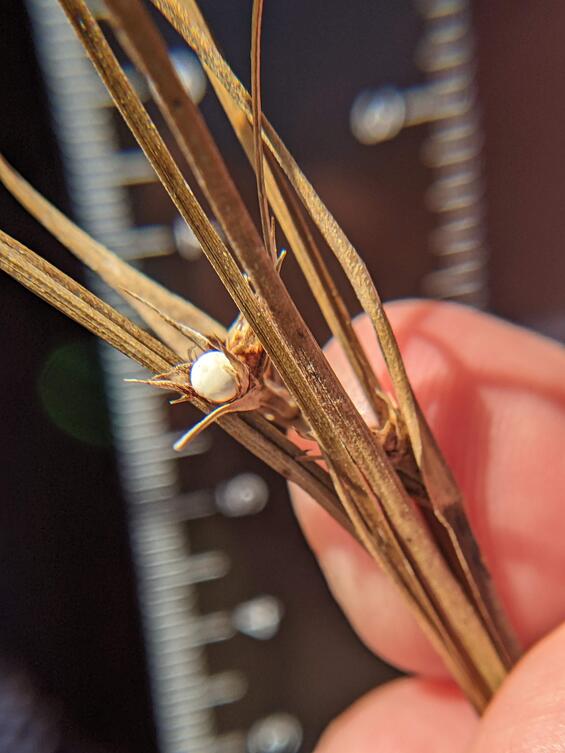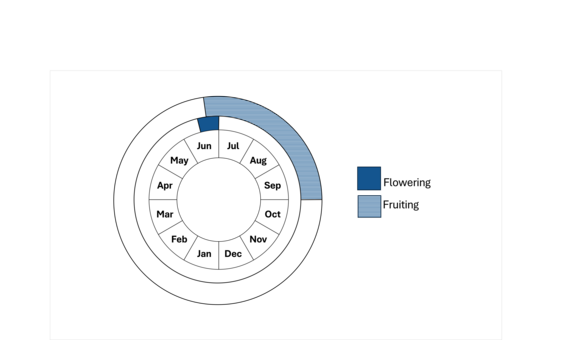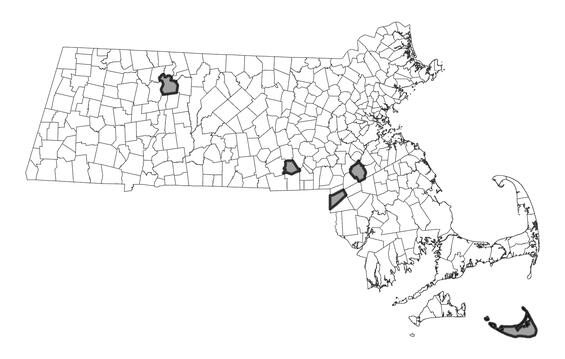- Scientific name: Scleria triglomerata
- Species of Greatest Conservation Need (MA State Wildlife Action Plan)
- Endangered (MA Endangered Species Act)
Description

Tall nut-sedge is a perennial member of the Sedge family (Cyperaceae) that typically grows in full sun on disturbed, moist or wet, sandy sites. This species grows to 1 m (3 ft) tall, has thick knotty rhizomes, and leaves less than 1 cm (0.4 in) wide. While tall nut-sedge is the most common Scleria species in North America, it has declined in New England in recent decades. It can be identified by its smooth, white achenes (dry, single-seeded fruits) in late summer.
A technical manual should be used to identify tall nut-sedge and other Scleria species. Tall nut-sedge has tufted culms that are glabrous, 0.4-1 m (1.3–3.3 ft) tall, and sharply triangular, growing from hard, knotty (nodulose) rhizomes. The culms often arch over the plant’s distinctive bright yellow-green leaves. Leaves are 3-9 mm (0.12-0.35 in) wide, rigid, and often pubescent, arising near the base of the plant. The lower part of the sheath is purplish, and the blades are linear and finely pleated, with very fine fringe hairs along the margins. The achene is relatively large at 3 mm (0.12 in), with a smooth, white, enamel-like surface, and an unlobed hypogynium that lacks tubercles and instead has dense, minute papillae.
Other Scleria species in Massachusetts have narrower leaves (1-3.5 mm; 0.04-0.14 in), and a hypogynium that lacks minute papillae and is either lobed or has tubercles. S. minor is a similar species that occurs from New York south but is not known from Massachusetts.
Life cycle and behavior
This is a perennial species.

Population status
Tall nut-sedge is listed under the Massachusetts Endangered Species Act as Endangered. All listed species are protected from killing, collecting, possessing, or sale, and from activities that would destroy habitat and thus directly or indirectly cause mortality or disrupt critical behaviors. Massachusetts Natural Heritage & Endangered Species Program database has 17 records from 8 counties across the state. Four of those records are within the last 25-year period.
Distribution and abundance
Tall nut-sedge is the most common and widespread species of the genus Scleria in North America. It occurs along the Atlantic coastal plain north to Massachusetts and New York, west to Texas, south to Florida, and in Puerto Rico.

Distribution in Massachusetts
1999-2024
Based on records in the Natural Heritage Database
Habitat
Tall nut-sedge is found in a variety of habitats with a variety of associated species as long as there is some history of past soil distubance. It occurs in openings in woodlands, moist, sandy fields, and low, seasonally wet, sandy areas, in an open acidic fen, and in a sandy, seasonally wet powerline right of way on the edge of access roads. It prefers full sun and disturbed habitats, generally in acidic, moist soils. Associated species at one site include red maple (Acer rubrum), early goldenrod (Solidago juncea), Pennsylvania sedge (Carex pensylvanica), wintergreen (Gautheria procumbens), yellow star-grass (Hypoxis hirsuta), black huckleberry (Gaylussacia baccata), blueberries (Vaccinium spp.), bayberry (Morella pensylvanica), and little bluestem (Schizachyrium scoparium). There seems to be little consistency in associated species except Carex vestita (velvet sedge) and Carex swanii (Swan's sedge) are often co-occurring. Both of these species are found in open to partial shade on sandy disturbed soils. In New York, one of the sites where it occurs is on the ice-scoured shores of a large river system.
Healthy habitats are vital for supporting native wildlife and plants. Explore habitats and learn about conservation and restoration in Massachusetts.
Threats
This species needs a fine balance of disturbance to reduce competition but not so much as to cause direct harm to the population. It’s natural habitat Its habitat could be disturbed in the non-growing season to open it up for seed germination and colonization, but direct disturbance should be prevented during the growing season.
Conservation
This species is hard to detect and blends in very well in a grassy meadow situation. It is nearly impossible to see and identify until it is in fruit which is late in the year. Evidence of this occurred in 2022 when a new population was found in Franklin County, after a 3000 hour county-wide survey effort by expert botanists, ending in 2019, turned up no populations (Bertin et al. 2020). More survey work is needed to fine new populations, and current populations are insufficiently monitored.
Tall nut-sedge is an early successional species that requires some form of disturbance to create and maintain appropriate habitat. Cutting, mowing, or prescribed fire may help to maintain extant populations. Soil scarification may also be needed for tall nut-sedge to successfully establish. Known habitat locations should be protected from dramatic changes in light or moisture conditions. All active management of rare plant populations (including invasive species removal) is subject to review under the Massachusetts Endangered Species Act and should be planned in close consultation with the MassWildlife’s Natural Heritage & Endangered Species Program.
The exact ecological needs of this species are not well understood. As this plant is under-surveyed, standard information is needed such as lists of associated species, comments on water and habitat quality and threats, and assessments of soil conditions and phenology. Research is needed to determine whether this plant can be grown in a greenhouse or garden setting for purposes of reintroductions. If habitat degradation accelerates losses of current populations, this strategy could prove useful to long-term conservation of this species.
References
Anon. Whip Nut Sedge Guide - New York Natural Heritage Program. Website https://guides.nynhp.org/whip-nut-sedge/ [accessed 2 May 2025].
Bertin, R. I., M. G. Hickler, K. B. Searcy, G. Motzkin, and P. P. Grima. 2020. Vascular Flora of Franklin County, Massachusetts. New England Botanical Club. 390 pp.
Clark, F.H. 2004. Scleria triglomerata Michx. Tall Nutrush, Whip Nutrush Conservation and Research Plan for New England. New England Wildflower Society. Framingham, MA.
Flora of North America Editorial Committee, eds. 2002. Scleria triglomerata Michaux. in Flora of North America North of Mexico, vol. 23. Oxford University Press, NY.
Gleason, H. A., and A. Cronquist. 1991. Manual of Vascular Plants of Northeastern United States and Adjacent Canada, 2nd edition. The New York Botanical Garden, Bronx, NY.
Haines, A. 2011. Flora Novae Angliae – a Manual for the Identification of Native and Naturalized Higher Vascular Plants of New England. New England Wildflower Society, Yale Univ. Press, New Haven, CT.
NatureServe. 2009. NatureServe Explorer: An online encyclopedia of life [web application]. Version 7.1. NatureServe, Arlington, VA. http://www.natureserve.org/explorer
Contact
| Date published: | May 12, 2025 |
|---|